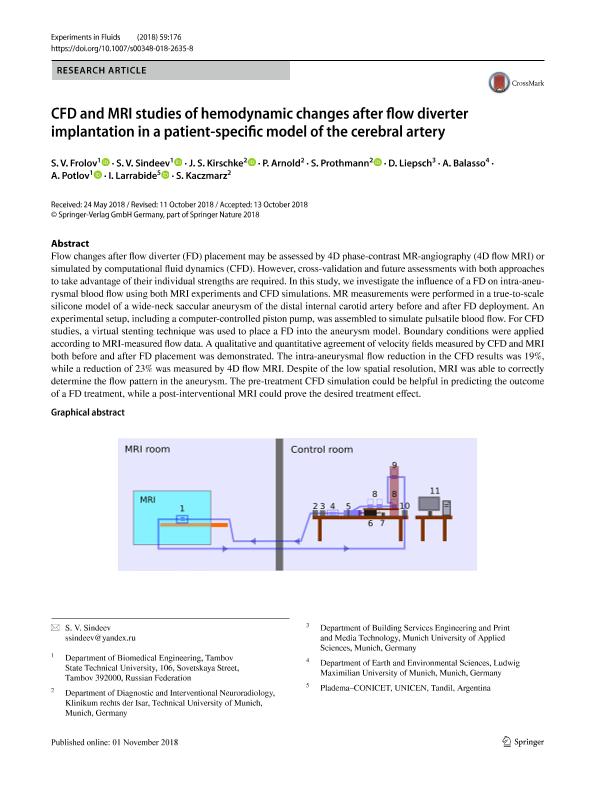Artículo
CFD and MRI studies of hemodynamic changes after flow diverter implantation in a patient-specific model of the cerebral artery
Frolov, S. V.; Sindeev, S. V.; Kirschke, J. S.; Arnold, P.; Prothmann, S.; Liepsch, D.; Balasso, A.; Potlov, A.; Larrabide, Ignacio ; Kaczmarz, S.
; Kaczmarz, S.
 ; Kaczmarz, S.
; Kaczmarz, S.
Fecha de publicación:
11/2018
Editorial:
Springer
Revista:
Experiments In Fluids
ISSN:
0723-4864
Idioma:
Inglés
Tipo de recurso:
Artículo publicado
Clasificación temática:
Resumen
Abstract: Flow changes after flow diverter (FD) placement may be assessed by 4D phase-contrast MR-angiography (4D flow MRI) or simulated by computational fluid dynamics (CFD). However, cross-validation and future assessments with both approaches to take advantage of their individual strengths are required. In this study, we investigate the influence of a FD on intra-aneurysmal blood flow using both MRI experiments and CFD simulations. MR measurements were performed in a true-to-scale silicone model of a wide-neck saccular aneurysm of the distal internal carotid artery before and after FD deployment. An experimental setup, including a computer-controlled piston pump, was assembled to simulate pulsatile blood flow. For CFD studies, a virtual stenting technique was used to place a FD into the aneurysm model. Boundary conditions were applied according to MRI-measured flow data. A qualitative and quantitative agreement of velocity fields measured by CFD and MRI both before and after FD placement was demonstrated. The intra-aneurysmal flow reduction in the CFD results was 19%, while a reduction of 23% was measured by 4D flow MRI. Despite of the low spatial resolution, MRI was able to correctly determine the flow pattern in the aneurysm. The pre-treatment CFD simulation could be helpful in predicting the outcome of a FD treatment, while a post-interventional MRI could prove the desired treatment effect.
Archivos asociados
Licencia
Identificadores
Colecciones
Articulos(CCT - TANDIL)
Articulos de CTRO CIENTIFICO TECNOLOGICO CONICET - TANDIL
Articulos de CTRO CIENTIFICO TECNOLOGICO CONICET - TANDIL
Citación
Frolov, S. V.; Sindeev, S. V.; Kirschke, J. S.; Arnold, P.; Prothmann, S.; et al.; CFD and MRI studies of hemodynamic changes after flow diverter implantation in a patient-specific model of the cerebral artery; Springer; Experiments In Fluids; 59; 11; 11-2018
Compartir
Altmétricas



